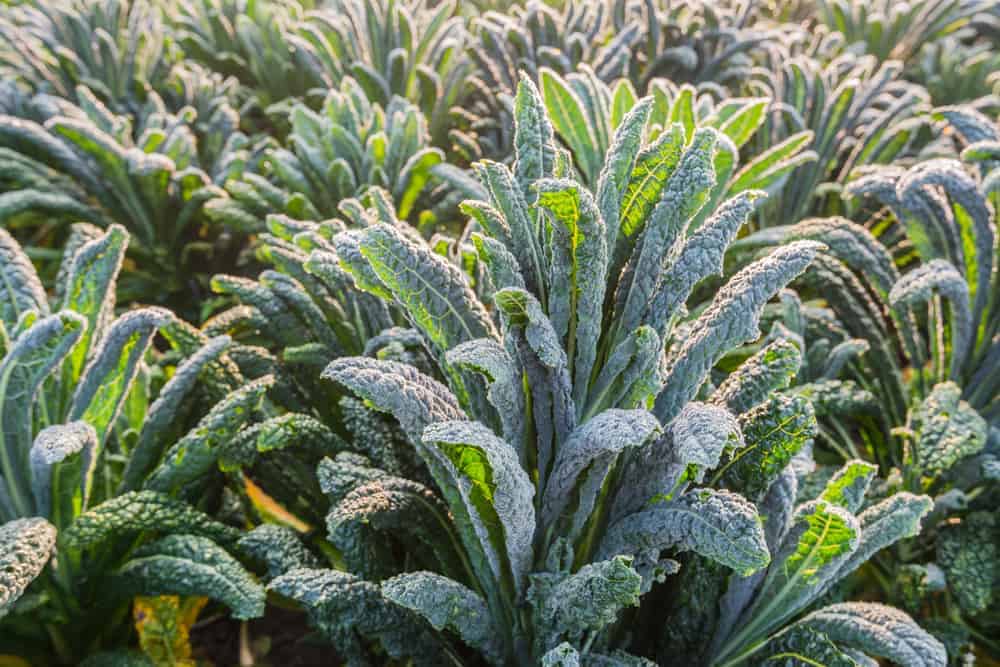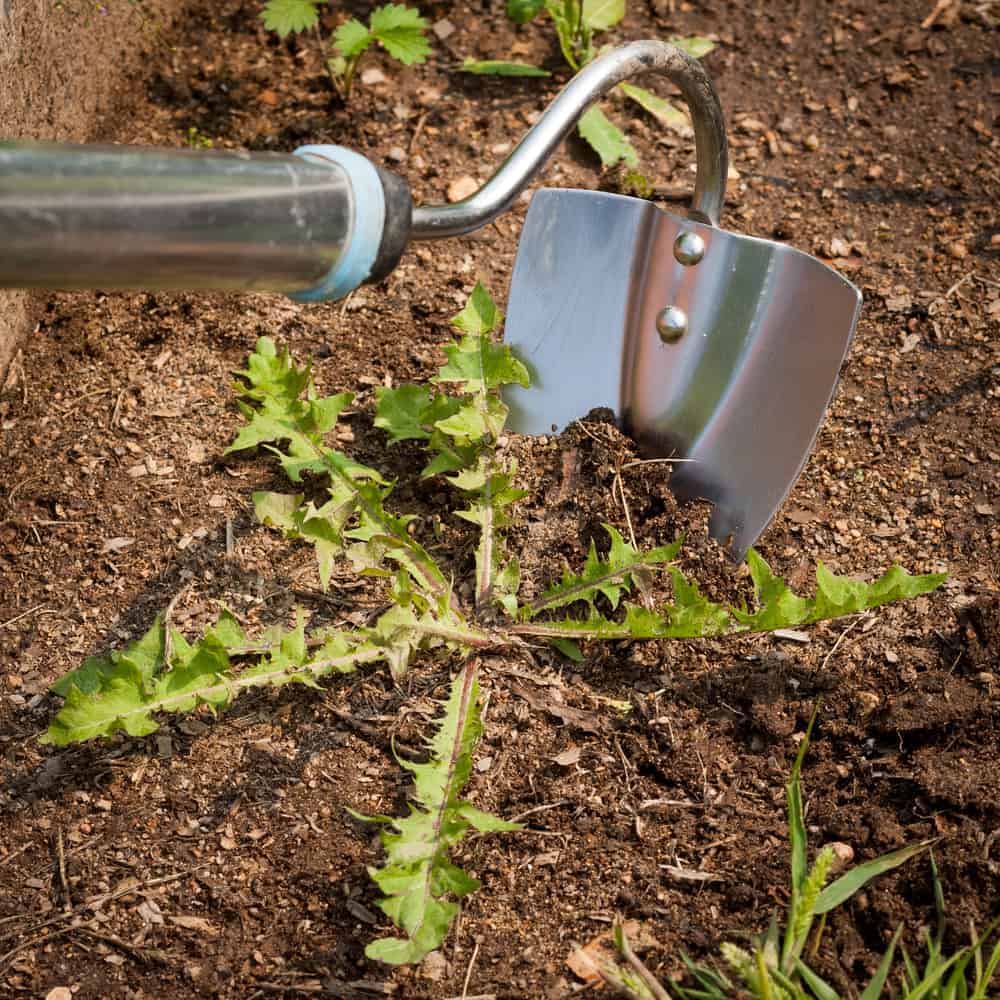Kale (Brassica oleracea) is a fantastic, cool-season vegetable with foliage growing from a central stem. You can choose to grow them as food or as an ornamental plant thanks to its curly, purple or shaded-green leaves. Since kales are rich in vitamins A, C, E, and K, calcium, iron, and fiber, those plants are worth growing.
Moreover, these veggies are an incredible source of carotenoids which increase the level of optimism in humans. The best thing is that you can harvest it once a week and you actually need just three plants to provide enough greenery for your family of four.
Choose the Best Kale for You

You can grow your kale as eatable greenery or for ornamental purposes which leaves are too large and fibrous. However, you can enjoy their purple, blue, dark-green, or red colors.
If you prefer using kale as food, you should pick out the best variety for you. Believe it or not, you can determine the most delicious kale types according to the shape of their foliage:
- Curly leaves – Kale with literally curly leaves are probably the best-spread types of this vegetable.
- Bumpy leaves – These types have ugly, slightly deformed, and rough leaves. Even though you may find them repulsive, I assure you that those leaves are sweet and highly delicious.
- Rape kale – You can grow these hearty greens throughout winter thanks to their fibrous structure.
- Plain leaves – You will enjoy this variety full of broad, smooth foliage.
- Leaf and spear – This type is a cross between the varieties with curly and plain leaves. You can eat them as baby green or after foliage matures entirely.
The Most Popular Kale Varieties
I will list you here my favorite types of kale. I hope you will enjoy them as much as I do.
Red Russian kale

It is probably the most popular variety of kale with soft, wide-toothed, and thin light green foliage and a red stem. This kale is highly resistant to pests and most diseases. Plus, it contains more essential minerals and vitamins than other varieties of this vegetable.
White Russian kale

If you plant this kale early in the spring, you will get an extended harvest. Since this type tolerates the cold and wet soil, you can start with sowing it indoors a month and a half before the last frost.
Siberian Kale

This type is well-known because of its yellow flowers, round, glossy leaves, and long, thin stems. However, most gardeners appreciate the fact that seeds produce delicious oil (Canola Oil) full of omega-3 and omega-6 fatty acids.
Winter red kale

These delicious winter garden veggies have flat, green, small-sized leaves with wide ‘teeth’ and bright red stems.
Lacinato kale

Easily recognizable by thick leaves, this kale type originates from Tuscany is an exceptional addition to soups, pesto, and minestrone.
Scarlett kale

I am amazed by a dark purple color of this exotic plant’s curled foliage. Don’t cook them, but enjoy delicious salads. Since they are resistant to low temperatures, you will enjoy this veggie during most of the winter.
How to Plant Kale in Your Garden
Where to grow kale

In general, kale will grow in most conditions, including sandy soils and part shade. However, this crop will thrive better if you plant it in the enriched soil. Plus, kale prefers growing in full sun.
An excellent solution is planting your veggies in the ground with about 30 pounds (13.6 kg) of compost per 100 sq ft (9.3 m2) added during the end of the previous season or fertilizer rich in nitrogen, potassium, and phosphorus.
When to grow kale
Expect your kale germinate when the temperatures are at least 42 F (5.5 C) and not higher than 95 F (35 C). An interesting fact is that your kale will have the best flavor when growing when the weather is colder.
Sowing

You can plant this useful veggie at any time between early spring and summer. The last moment for planting is summertime, and you can expect to harvest crop in winter until the ground freezes.
The process is simple and includes mixing 3 to 4 inches (7.6 – 10 cm) of soil with 1.5 cups of fertilizer (5-10-10 is the best option) per a row of 25 feet (7.6 m). Put seeds about 0.25 to 0.5 inches (0.6 – 1.3 cm) deep hole, and take care that the soil is well-drained and light.
Transplant your seedlings after two weeks. They should be 4 to 6 inches (10 – 15.2 cm) tall and spaced approximately 8 to 18 inches (20 – 45.7 cm). Depending on the chosen variety, rows should be 18 inches (46 cm) apart.
In a case that you decide to sow seeds directly into the ground, put them into a 0.5 inches deep (1.3 cm) hole in rows 6 inches (15.2 cm) apart. Don’t forget to thin them to about 3 inches (7.6 cm) apart over time.
How to Care Kale in Your Garden
Light

Since you grow kales for their leaves, it is logical to put them in full sun most of the day even though they can thrive in partial shade. Take care to provide at least six hours of sun daily, but if you want to get stocky and leafy plants, provide more sun for this veggie.
Soil
Those plants usually like growing in the soil rich in organic matter, especially nitrogen. The ideal pH for the best growth is 6.5 to 6.8. If you don’t have any problem with clubroot in your garden, kale will tolerate even a lower level of pH (at least 5.5).
Water

Keep your vegetable well-watered to get sweet and crisp leaves. In dry conditions, its foliage can become bitter and harsh. If you mulch the area around your plants with ground leaves, straw, hay, and pine needles, the soil will stay cold, weed-free, and appropriately moist, and you will get a desirable flavor of your veggie. Also, you should provide approximately 1 to 1.5 inches (2.5 – 3.8 cm) of water a week for them.
Temperature
The optimal temperatures of the soil for planting this biennial veggie are 60 to 65 F (15.5 – 18.3 C). If you live in the region with mild winters, adequately watered kale can thrive throughout winter.
Fertilizer
After adding fertilizer high in nitrogen, poultry manure, or compost to the ground while planting kale, mix it with 3 to 4 inches (7.6 – 10 cm) of the soil. In average, you will need to add 0.5 cups of fertilizer for every 10 feet (3 m) of the row. As long as your kale grows lush and healthy, you don’t need to add more organic matter into the ground.
Weeding

Regularly weeding is essential if you want to get lush foliage of these veggies. Purchase an oscillating stirrup hoe, and discover how efficient this old-fashioned tool can be.
Except weeding, regular hoeing will break up the surface of the ground and allow air and moisture to penetrate inside. Consequently, you will increase microbial activity and encourage better absorption of nutrients through the root system.
Removing dead leaves

As soon as noticing yellow or discolored foliage, you should remove them right away from your plants. Those leaves are an excellent base for sprouting diseases, especially fungi infection.
Kale varieties |
Harvesting |
| Hanover Late Seedling |
68 days |
|
Dwarf Siberian |
65 days |
| Blue Curled Scotch |
65 days |
|
Greenpeace |
65 days |
| Winterbor |
60 to 65 days (hybrid) |
|
Konserva |
60 days |
| Squire |
60 days |
|
Dwarf Green Curled |
60 days |
| Verdura |
60 days |
|
Dwarf Blue Curled |
55 days |
| Dwarf Blue Scotch |
55 days |
|
Blue Knight |
55 days (hybrid) |
| Blue Armor |
45 to 75 days (hybrid) |
|
Red Russian |
40-60 days |
How to Harvest Kale

It is possible collecting very young leaves of those biennial veggies, but the right time for harvesting is in the fall when the plant is 8 to 10 inches (20 – 25.5 cm) high, and their leaves are approximately the size of the male hand. Use a knife or scissors for cutting leaves, and start picking the lowest (oldest) ones one by one and keep collecting toward the center.
To encourage plant growth, you should always leave a minimum of four to five central leaves. That way, you can harvest new foliage from the same plant again after a week.
In some zones, it is possible to collect new leaves throughout the winter if the temperatures are above 20 F (-6.7 C). It is enough to keep them safe by adding thick mulch around plants or using row covers. Moreover, their taste will improve after the first frost.
Overwintered kale will bolt in spring. The production of yellow flowers will signal you that you should remove old plants and make space for new crops.
If you prefer micro-greens, you can harvest your kale 12 to 20 days after planting. There is also the possibility to collect baby greens approximately 20 to 30 days after planting.
How to Store Kale

Pick mature kale leaves early in the morning, rinse them, and refrigerate right away. If you pack those vegetables in a plastic bag, your kale can survive in the fridge for a few days.
If you want to freeze leaves, plunge them into boiling water and cool quickly in a bowl full of ice water. Your kale will also be delicious if you dry them.
Kale Pests and Diseases
Usually, your kale won’t have any severe issue. By picking off unhealthy, yellow leaves and add compost and water regularly, you can reduce most damages insects can cause to your vegetable.
Caterpillars

These creatures feed on foliage and leave a lot of tiny holes all over the leaves. If you have just a few kales in your garden, you can hand-pick the caterpillars off. Using insect-proof mesh is an excellent way to prevent the laying of eggs and keep your plants safe.
Cabbage root fly

Those small grey flies lay their eggs at the base of your kale seedlings. Hatched larvae will feed on the kales’ roots and consequently cause stunting growth and the destruction of the plants. As a result, your veggies will probably wilt and die.
Growing plants under insect-proof mesh may prevent damaging of your seedlings. The other solution is placing collars around the base of your kales. Both of them will stop the fly laying the eggs.
Harlequin bugs

You can spot those black-and-orange bugs pretty often on your kale when they are really old. Instead of fighting insects, simply pull up mature plants and compost them.
Aphids

Outbreaks of that gray-green menace are not rare. You can spot clusters within the leaves’ folds. Get rid of them by using insecticidal soap and destroying infested leaves.
Clubroot

This tricky disease is rare in new gardens. It may arrive there when you purchase infected transplants. Once appeared, the cysts may survive approximately nine years in the ground. Be careful and always keep in mind that you can’t plant any plant from the cabbage family while you have clubroot in the soil.
When you notice wilt, reddish-purple foliage and swollen, smelly, and deformed roots, you will know that your kales have caught this infection. Prevent this disease by purchasing resistant varieties. If the disease occurs, burn affected roots.
Birds
Pigeons often eat seedlings, foliage, buds, and fruits of these veggies. Use netting to cover your plants and protect them from birds.

Leave a comment